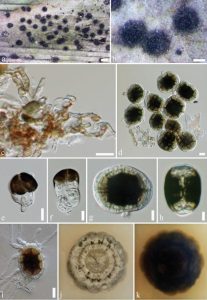Hermatomyces pandanicola Tibpromma, D.J. Bhat & K.D. Hyde, sp. nov., Index Fungorum number: IF 552308
Etymology: named for its occurrence on the host plant Pandanu
Holotype: MFLU16-1896
Saprobic on dead leaves of Pandanus odorifer. Sexual morph: Undetermined. Asexual morph: Colonies on natural substrate dry, blackish brown, velvety, circular, doughnut-shaped, dull, consisting of a sterile mycelial outer zone and a round, glistening, abundantly sporulating centre, conidia readily liberated when disturbed. Mycelium 1.2–2.8 μm wide, superficial, composed of a network of branched, septate, brown, thick-walled hyphae. Conidiophores 1.2–9.8 μm long, 1.3–3.7 μm wide, micronematous, straight or flexuous, hyaline, smooth, unbranched, arising from prostrate hyphae at the centre of circular colony. Conidiogenous cells holoblastic, monoblastic, integrated, terminal, cylindrical, hyaline. Conidia dimorphic, thick-walled, smooth: lenticular conidia 12–15.7 µm high, 20–30.1 µm diam. wide (x̅ = 19.2 × 24.8 µm, n = 30), with central cells dark brown to black, with peripheral cells subhyaline to pale brown, not constricted at septa, smooth, in lateral view obovoid, guttulate, hyaline to light brown at lower and upper ends, dark brown at central cells; cylindrical conidia 13.2–20.6 µm high, 8.9–11.9 µm wide in broadest part of lower cells (x̅ = 16.6 × 10.1 μm, n = 20), granulate, with 2 rows of 2 cells in each column arising from a common basal cell, lower cells usually hyaline, cylindrical, swollen, constricted at septa, turbinate and dark brown at upper cell.
Culture characteristics: Colonies on MEA at room temperature (22–25 ºC) reaching 1.5 cm in 1 week, irregular with wavy margin, wrinkled on media, white-grey, not sporulating in culture after 4 months.
Material examined: THAILAND, Phang Nga Province, Thap Put District, on dead leaves of Pandanus odorifer (Pandanaceae), 17 December 2015, S. Tibpromma & K.D. Hyde, KB018 (MFLU16-1896, holotype, HKAS94530, isotype); ex-type living culture, MFLUCC16-0251.
Notes: Hermatomyces pandanicola is compared with H. indicus, as both produce lenticular and cylindrical or turbinate conidia. The lenticular conidia in both species are similar in shape, size and colour. However, the cylindrical conidia of H. pandanicola have 2 rows of 2 cells in each column, arising from a common basal cell (13.2–20.6 × 8.9–11.9 μm), with lower cells usually hyaline, cylindrical, swollen, constricted at septa, turbinate and dark brown at upper surface. In H. indicus the conidia are composed of 6–7 cells in 2 rows (22.4–35.4 × 11.4–21.6 μm) (Prasher & Prasher 2014). The morphology of H. pandanicola is supplemented with molecular data in this study.

